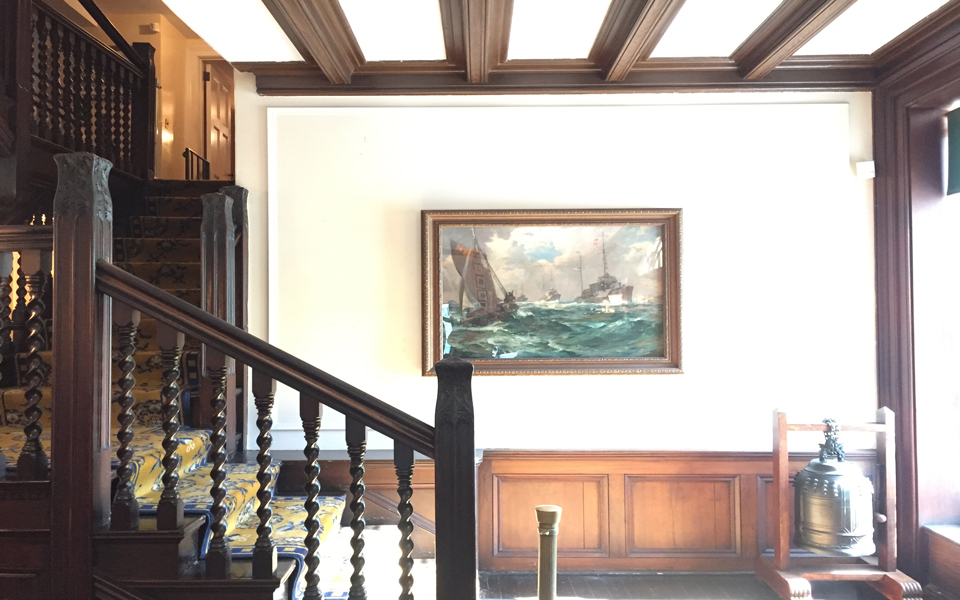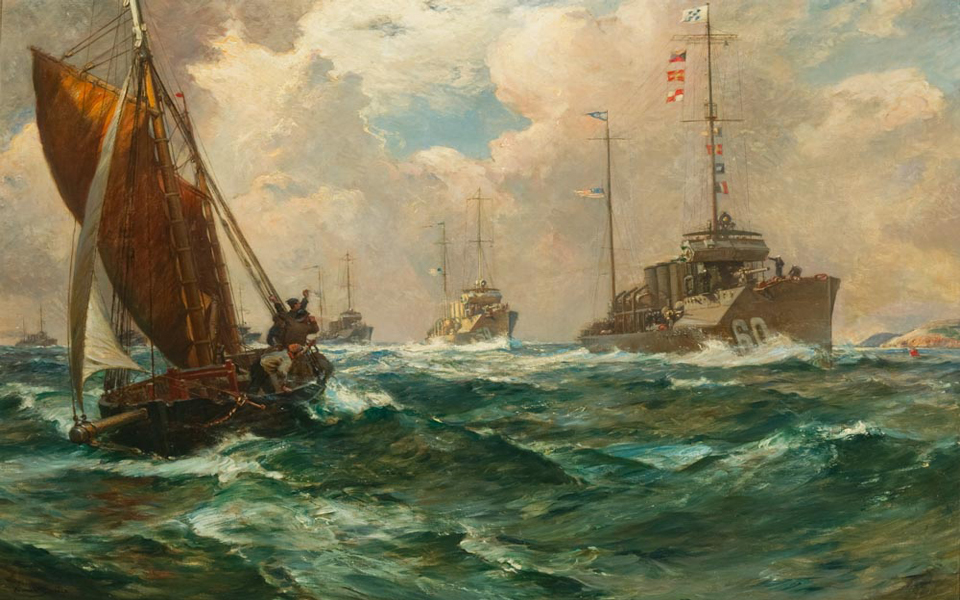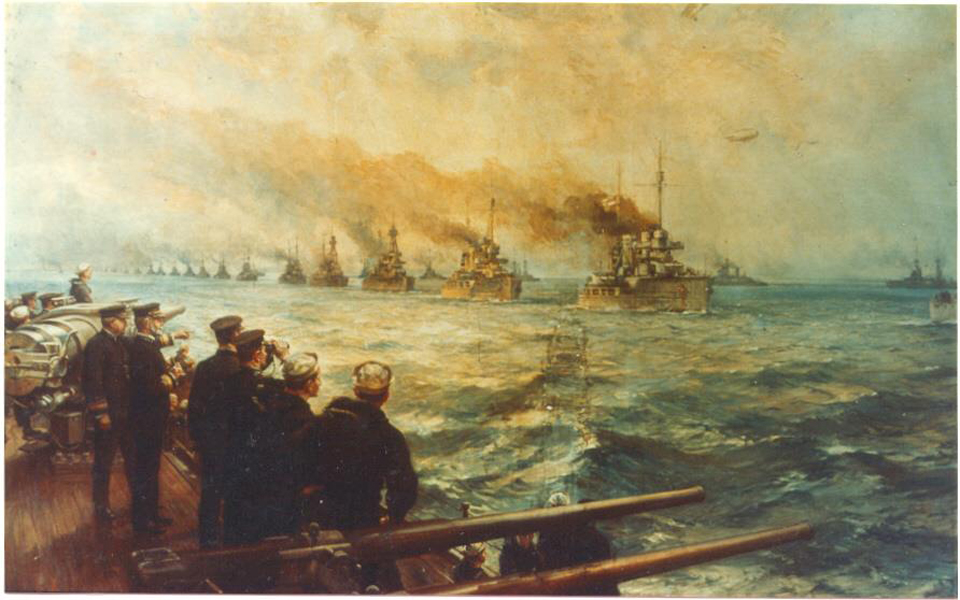
"Return of the Mayflower," on permanent exhibit at the Home of Franklin D. Roosevelt National Historic Site.
Return of the Mayflower commemorates the arrival of the first American destroyers sent to aid the British in World War I. The painting shows destroyers approaching Queenstown, Ireland on May 4, 1917 to help hunt down German submarines that were fast cutting off the transport to England. In the left foreground, fisherman in their boat are welcoming U.S. destroyers. The arrival of these America ships was commemorated in this historic painting by the British artist Bernard F. Gribble, Return of the Mayflower, the ship which over 300 years earlier had brought British settlers to the New World.
On April 10, 1917 Rear Admiral William S. Sims learned from 1st Sea Lord Admiral Sir John Jellicoe that Britain was perilously close to being starved into defeat by the German U-Boats. He sent an urgent plea to Washington for destroyers to aid the hard pressed Royal Navy. A reply was not long in coming. On April 14 Commander Joseph K. Taussig received orders to fit out his Destroyer Division 8 for Long and Distance Service. Three weeks later the flotilla of six sleek destroyers streamed into British waters and a heartfelt welcome is depicted in Bernard Gribble’s painting.
Gribble also painted a companion canvas. Surrender of the German Fleet to the Grand Fleet at Scapa Flow with Admiral Sims and Rodman on the U.S. Flagship “New York,” a historical painting commemorating the surrender of the German Fleet on November 21, 1918.
Gribble originally painted these two subjects of mural size (5x7 feet), which now hang in the U.S. Naval Academy Museum in Annapolis, Maryland. In 1919, Franklin D. Roosevelt, through correspondence with Admiral William S. Sims, who was in London at the time, commissioned Gribble to paint smaller versions of these two paintings for his personal collection. When completed, they were sent to the U.S. Navy Department in Washington where FDR had his office as Assistant Secretary of the U.S. Navy. After FDR left the Navy department, his painting first hung in the entrance hall of Springwood and later in the Oval Room of the White House. FDR brought them back to Springwood in 1942.
History of FDR’s Gribble Paintings
Prized by the president among his naval collection, FDR’s versions were placed in the Big House on two separate occasions. They may have been hanging in the Big House by 1921, as indicated in a letter from FDR to Gribble (January 7, 1921):
"My dear M. Gribble:
I have been a long time in writing you to convey my thanks and appreciation for the two paintings. "Return of the Mayflower" met with a series of vicissitudes due largely to my rapid change of movements. It got held up in the Customs House for several months; it was then sent to my office in Washington by mistake, as I wanted it at my place in the country."1
In 1933, FDR loaned these two paintings with other works from his naval collection to the Corcoran Gallery of Art in Washington, DC.2 Following the exhibition, they remained with President Roosevelt in Washington—they appear in photographs of the Oval Office with other framed works from his collection.3
In 1942, FDR removed them from the Oval Office and brought them again to the Big House to replace the Sevastopol, a large marine painting presented to the President by Joseph E. Davies, U.S. Ambassador to Russia.4 The Gribbles remained in the Big House until FDR’s death, after which his son John Roosevelt removed the paintings. They remained in the possession of his widow until 2001 when they were jointly acquired by the National Park Service and the National Archives. The Return of the Mayflower was accessioned into the collection for the Home of Franklin D. Roosevelt National Historic Site and is once again on exhibit as the President placed it in the final years of his life. Its companion, Surrender of the German Fleet, was accessioned into the National Archives and is on exhibit today in the President’s Study at the FDR Library.

(The So Called) "Return of the Mayflower," by Bernard F. Gribble (British, 1873-1962). Oil on Canvas, painted 1919. Home of Franklin D. Roosevelt National Historic Site.
 "Surrender of the German Fleet," by Bernard F. Gribble (British, 1873-1962). Oil on Canvas, painted 1919. Franklin D. Roosevelt Presidential Library and Museum.
"Surrender of the German Fleet," by Bernard F. Gribble (British, 1873-1962). Oil on Canvas, painted 1919. Franklin D. Roosevelt Presidential Library and Museum.
1 The Roosevelts did not remain in Washington after his tenure as Assistant Secretary of the Navy ended in 1920, so it seems likely that although they were delivered to Washington by mistake, they did not remain there.
2 Catalogue for an “Exhibition of Paintings, Prints and Models of Ships and other Marine Subjects Lent by The President of the United States,” April 5 through May 3, 1936.
3 See White House Historical Association website which features photographs of FDR’s Oval Office. http://www.whitehousemuseum.org/floor2/yellow-oval-room.htm
4 See Franklin D. Roosevelt Presidential Library catalog record and related correspondence (copies with park curator). For removal of Sevastopol from Big House to the FDR Library, see Margaret Suckley to Grace Tully, May 27, 1942, Franklin D. Roosevelt Presidential Library, Sevastopol Collection File (copies with park curator). Presumably this is when the Gribbles were placed on the stair landing.
